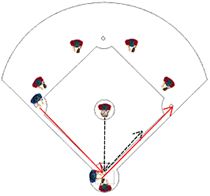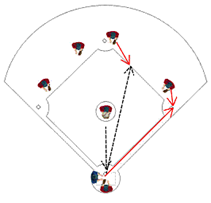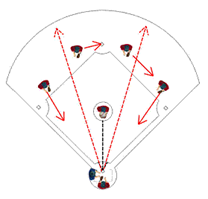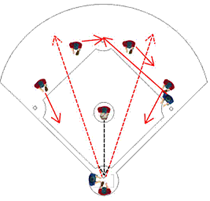|
5 Hitting Situations for Which Your Players Should
During this blog post, I’m going to go over some special baseball hitting situations that your team will most likely face at one point or another.
A suicide squeeze is used by a team that has a good bunter at the plate and a pitcher who has thrown a high percentage of strikes. The runner is going to break as the pitcher’s front foot touches the ground. If the ball is bunted safely on the ground, the runner scores easily. The batter is going to square as the pitcher reaches his point of release. Therefore, the pitcher cannot change direction of the pitch.
A drag bunt can be particularly effective when there is a runner on second, or first and second, and no outs. It is also an effective play when the third baseman is playing deep and you have a runner on third with two outs.
The number of outs is really not important because the third baseman is giving us a drag bunt situation. It’s more of an element of surprise than anything else. Since the third baseman is playing deep, he’s giving that opportunity to us. It doesn’t always require that the bunter be an excellent base runner or be fast.
Push Bunt In this type of baseball hitting situation, the second baseman is covering up the middle and the bunter pushes the ball between the first and second basemen. It forces the pitcher and the first baseman to make a decision as to who’s going to field the ball and who’s going to cover the base. If the ball is bunted past the pitcher, it is not a foot race between the runner and the pitcher to first base. It’s an excellent play when the second baseman is pulled up to the middle and you have a left-handed pitcher on the mound. Slash Bunt When the hitter shows bunt, it makes the infield start to move in order to cover the bunt, and the hitter would then try to hit a ground ball in a hole being vacated by an infielder. Oftentimes he is going to be able to hit the ball either in the hole where the shortstop may vacate or in between the first and second basemen.
In this baseball hitting situation, with less than two outs, the batter squares, shows bunt. As the infielders begin to move, pulls the bat back, and gets a ground ball in the hole where the shortstop or second baseman has vacated, thus advancing the runner from first to third and arriving safely at first himself. Did you learn a little something from these various baseball hitting situations? Share your thoughts and comments below.
|
|
|





 In this baseball hitting situation, the third baseman is playing deep. We have a hitter at the plate who is an excellent bunter. It is a situation that requires the bunter to be accurate in trying to get the ball down the line.
In this baseball hitting situation, the third baseman is playing deep. We have a hitter at the plate who is an excellent bunter. It is a situation that requires the bunter to be accurate in trying to get the ball down the line.

 Slash and Run
Slash and Run